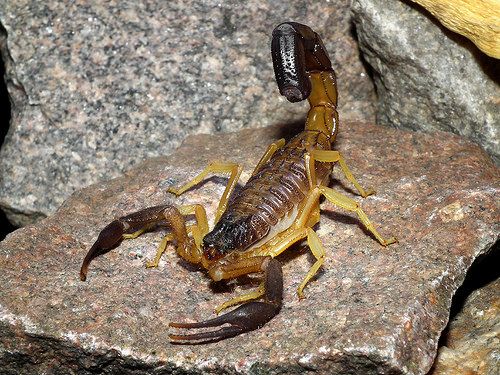The Hottentotta jayakari, a species shrouded in mystery and fascination, is a scorpion that commands both awe and caution. Dwelling in the arid and semi-arid regions, this creature is more than just its venomous sting. Let’s embark on a journey to uncover ten captivating facts about the Hottentotta jayakari, shedding light on its unique attributes and the role it plays in its ecosystem.
A Desert Specialist
The Hottentotta jayakari thrives in some of the most inhospitable environments, making its home in the sandy and rocky terrains. Its ability to adapt to extreme conditions is a testament to the resilience and evolutionary ingenuity of this species.
1. Master of Camouflage
One of the most striking survival strategies of the Hottentotta jayakari is its remarkable ability to blend into its surroundings. Its earth-toned exoskeleton mirrors the desert landscape, providing an effective camouflage against predators and prey alike.
2. Nocturnal Hunter
The Hottentotta jayakari emerges under the cloak of night to hunt. This nocturnal behavior allows it to avoid the scorching daytime temperatures and exploit the cover of darkness to ambush unsuspecting prey, primarily consisting of insects and smaller arthropods.
3. Venom: A Double-Edged Sword
The venom of the Hottentotta jayakari is a complex cocktail of neurotoxins, designed for both defense and subduing prey. While it poses a risk to humans, incidents of envenomation are rare, and the venom plays a crucial role in the scorpion’s survival strategy.
4. Burrowing Behaviors
To escape the extreme heat of its desert habitat, the Hottentotta jayakari is an adept burrower. It excavates shallow burrows under rocks or within sandy substrates, which serve as cool refuges during the day and safe havens for molting and nurturing offspring.
5. A Solitary Existence
Hottentotta jayakari scorpions lead largely solitary lives, coming together only for mating purposes. Their solitary nature is a crucial adaptation for survival in resource-scarce environments, minimizing competition and conflict among individuals.
6. A Long-Lived Arachnid
Compared to many arthropods, the Hottentotta jayakari has a relatively long lifespan, with some individuals living up to 5-6 years in the wild. This longevity is remarkable given the harsh conditions of their desert habitats.
7. Communication Through Vibrations
Like many scorpions, the Hottentotta jayakari communicates and senses its environment through vibrations. They use their sensitive pectines, comb-like sensory organs located on the underside of their abdomen, to detect prey, mates, and potential threats.
8. Parental Care
Female Hottentotta jayakari exhibit a strong maternal instinct, caring for their young by carrying them on their backs until they are ready to fend for themselves. This parental care ensures the survival of the next generation in the unforgiving desert environment.
9. A Keystone Species
Despite its venomous reputation, the Hottentotta jayakari plays a vital role in its ecosystem. As both predator and prey, it helps maintain the delicate balance of desert ecosystems, controlling insect populations and providing food for larger predators.
10. Adapting to a Changing World
The Hottentotta jayakari, like many desert-dwelling species, faces challenges from habitat loss and climate change. Its adaptability and resilience will be crucial for its survival as it navigates the impacts of an ever-changing environment.
The Hottentotta jayakari, with its intricate behaviors and adaptations, stands as a fascinating subject within the arachnid world. By delving into the lesser-known aspects of this scorpion’s life, we gain a deeper appreciation for the complexity and resilience of desert species. As we continue to explore and understand these remarkable creatures, we uncover the intricate tapestry of life that thrives even in the planet’s most extreme environments.
Frequently Asked Questions (FAQs) on Hottentotta Jayakari
1. What is Hottentotta jayakari and where can it be found?
Hottentotta jayakari is a species of scorpion known for its distinctive characteristics and potency. This species primarily inhabits arid and semi-arid regions in the Middle East, with notable populations in areas such as Oman and the United Arab Emirates. Its adaptation to harsh environments makes it a fascinating subject of study in terms of survival and behavior.
2. How does Hottentotta jayakari differ from other scorpion species?
Hottentotta jayakari sets itself apart with its robust build, potent venom, and specific environmental adaptations. Unlike many scorpion species that prefer more temperate climates, Hottentotta jayakari thrives in extremely arid conditions. Additionally, its venom composition is subject to ongoing research due to its unique properties and potential medical applications.
3. What are the primary characteristics of Hottentotta jayakari’s habitat?
The habitat of Hottentotta jayakari is characterized by extreme conditions, including high temperatures and low moisture levels. They are often found in sandy or rocky environments, where they can take refuge under stones or in burrows. Their ability to survive in such conditions highlights their remarkable adaptability.
4. Is the venom of Hottentotta jayakari dangerous to humans?
While the venom of Hottentotta jayakari is potent, fatalities in humans are extremely rare. However, a sting can result in significant pain, swelling, and other systemic reactions. It’s crucial to seek medical attention if stung, as individual reactions to venom can vary greatly.
5. What do Hottentotta jayakari scorpions feed on?
Hottentotta jayakari has a diet typical of many scorpions, preying on a variety of insects, spiders, and occasionally small vertebrates. Their role as predators helps control the populations of other small desert creatures, contributing to the ecological balance.
Featured image courtesy: https://in.pinterest.com/pin/456833955924505366/
